Nambu
World:
The Japanese rather euphemistically
refer to their more than decade-long war in
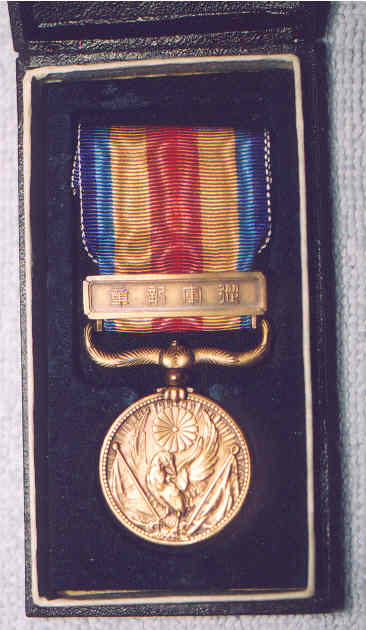
This photo shows a bit more detail.
The writing reads from right to left and says ju-gun-ki-sho, or “military service medal”. This seems to be the
common term for a service medal (i.e. one awarded for participating in a
campaign) as opposed to a “meritorious deeds medal”, kun-sho, awarded for a specific act or acts. I have read that the
bird is called a yata-no-karasu, a
giant red crow that supposedly guided the army of the first emperor, Jimmu,
through the mountains. The myth says that crow had three legs, but for some
reason they decided to show one with the normal two legs on the medal. Below it
are Rising Sun flags and above it, the Imperial
Chrysanthemum. If you look at the bird’s beak you will see it is also longer
and more pointed that of the kite shown on the early medal for service in
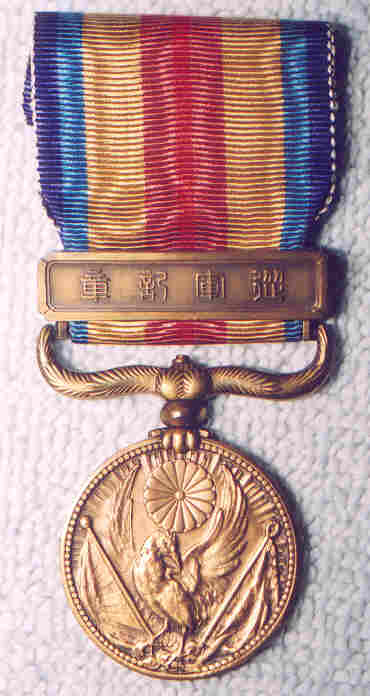
Here is the back. It has mountains
on top, water on the bottom, and what seem to be stylized clouds in the middle.
There are four characters as well. They read from right to left and say Shi-na ji-hen (China Incident).

This shot shows the original
wrapping paper on the left, the case in the middle and the medal on the right.
The large central column on the wrapping paper reads from top to bottom ju-gun-ki-sho, “military
service medal”. The smaller column in the upper right says Shi-na ji-hen, or “China Incident”. The small writing in the far
left corner says zo-hei-kyoku-sei, or
“Made by the Bureau of the Mint”. The box has a column of characters that say shi-na-ji-hen-ju-gun-ki-sho. This
translates to “China Incident War Medal”. The fighting there lasted right up
until
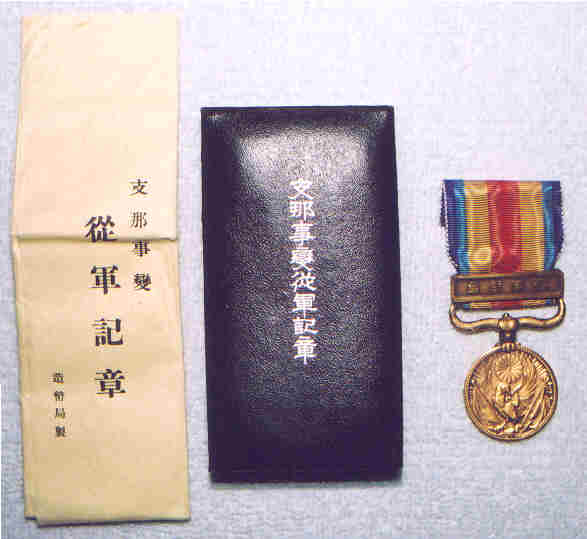
I have three certificates for this
medal. They are all the same size, measuring 418mm X
296mm (16-7/16” by 11-13/16”). The right side has the recipient and the date of
the award. The left side has the formalities from the Board of
Decorations. Each one has one watermark
in the upper right corner (shown below). On the first two there is nothing
printed or stamped on the back, but the third one does have some numbers
stamped on the back. They are all made from a thicker, stiffer material than
the World War One medal certificates. It seems to be the same stuff as for the
Manchurian campaign medal, almost like thin cardboard. The certificates I have
are in the names of Tsuchiya, Sakaguchi and Nakamura. We will look at them in
that order. I will go through all the details on the first one,
and then just the names on the other two (plus those numbers on the back of the
third).

This close-up of the right side has
the most important information.
First
column (far right): Shi-na-ji-hen-ju-gun-ki-sho-no-sho
Second
column from right: Riku-gun-ho-hei-tai-i-sho-nana-i-kun-yon-to-tsuchi-ya-ri-sabu-ro
Third
column from right: Shi-na-ji-hen-ju-gun-ki-sho-rei-no-mune-ni-yori
Fourth
column from right: Ju-gun-ki-sho-o-ju-yo-seraru
Last column
(on left): Sho-wa-ju-go-nen-shi-gatsu-ni-ju-kyu-nichi
This translates roughly as: “Certificate
for Medal for Military Service in the China Incident. Army Infantry Captain
Risaburo Tsuchiya [surname is Tsuchiya] is awarded the Medal for Military
Service in accordance with the regulations regarding the Medal for Military
Service During the China Incident. Dated April 29,
Showa 15 [1940].” I bought this certificate at an antique market in
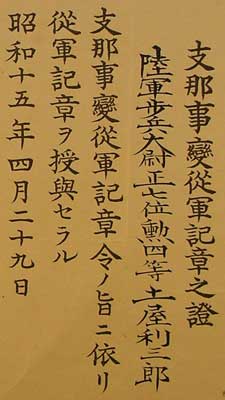
This close-up of the left side has
the formalities from the Board of Decorations (shokunkyoku).
First
column on far right: Sho-kun-kyoku-so-sai-ju-san-i-kun-it-to-shimo-jo-yasu-maro
Second
column from right: Dai-go-ju-ni-man-ni-sen-hachi-ju-go-go-o-motte-shi-na-ji-hen
Third
column from right: Ju-gun-ki-sho-bo-satsu-ni-ki-nyu-su
Last column
(on the left): Sho-kun-kyoku-sho-ki-kan-sho-roku-i-kun-go-to-mura-ta-ya-chi-o
With family names underlined, this
translates roughly as: “President of the Board of Decorations Yasumaro Shimojo,
Junior Third Rank, and Holder of the First Order of Merit. We have entered this
in the Register of Medals for Military Service During
the China Incident as number 522085. Secretary of the Board of Decorations
Yachiro Murata, Sixth Rank, Holder of the Fifth
Order of Merit” The red stamps at the ends of columns with names and titles
repeat the titles of the individuals whose names appear here, i.e. President of
the Board of Decorations or Secretary of the Board of Decorations, as the case
may be. I have gone out a bit on a limb here with my translation. Accompanying
the names of senior figures in pre-war
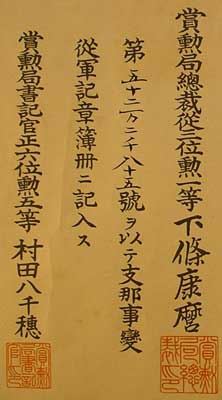
Here is a close-up of the artwork in the
centre-top of the certificate. The chrysanthemum in the centre is, of course,
the symbol of the Imperial Family.
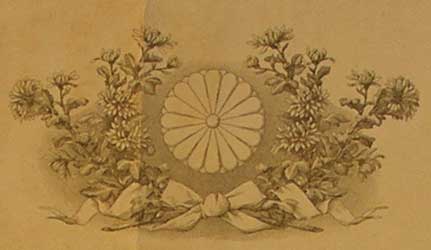
The red seal in the centre says Dai nippon teikoku
shokunkyoku-in, or “Seal of the Board of Decorations of the Empire of
Greater Japan”.
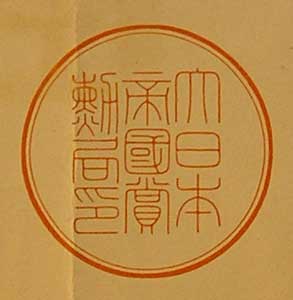
Here is the artwork in the
centre-bottom. It appears to be the same as on the Manchurian Incident
(Campaign) Medal certificate, although it and the border design seem to be done
in a grey-black ink instead of the brown used on the Manchurian Incident
certificate. If you compare this to the World War One and earlier service medal
certificates, you will note the addition of a tank, truck and two airplanes.
The light machine gun in the lower right appears to be a Type 11. You can see photos
of a real Type 11 in the section on Japanese Machine Guns. Note that the sword
leaning up against the butt of the machine gun is an older, Western-style sword
known as a kyu-gunto (old-style
military sword). It was replaced starting in 1934 with the more familiar
Japanese sword similar in style to the samurai sword, but some officers kept
carrying their older swords.
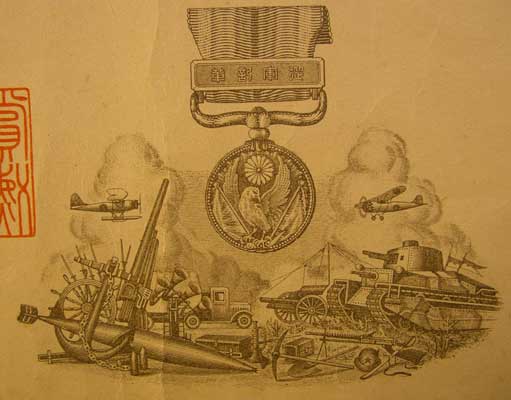
There is a watermark of a
chrysanthemum in the upper right. This photo appears very orange because I had
to put an incandescent light right behind this spot to get the image to be
bright enough to get a shutter speed fast enough for a sharp, clear shot.

This is another China
Incident military service medal certificate. I got this one from the same
dealer as the Tsuchiya certificates. I wanted one with a recipient from the
Navy. The size and layout are exactly the same as Mr. Tsuchiya’s certificate
above.

The language and date here are
identical to the Tsuchiya certificate shown above, except the recipient’s name
is given as moto-kai-gun-san-to-shu-kei-hei-so-saka-guchi-san-pei.
This translates to “former
Naval Third Class Paymaster Sergeant Sanpei Sakaguchi (I have not been
able to find the term equivalent to sergeant in the Imperial Japanese Navy, so
this is an approximation”). The left side gives the certificate number as
236367 but is otherwise identical to the Tsuchiya certificate.
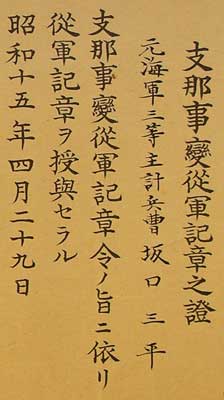
This last certificate in the name of
Nakamura was actually the first one I got. I bought it on eBay. The condition is
not as good as the other two, but basically it is the same. It has a strong
curl to it so I had to put flat steel strips under the burlap background and then
use small rare-earth magnets to hold the left and right edges down flat. That
is what the six little round dots are on the edges. I painted the magnets with
Humbrol #148 flat tan enamel to make their nickel-plating less conspicuous
(Humbrol is a brand of paint made for painting models).

Everything on the right side is the
same as the other two on the right side except the name line (second from
right) reads riku-gun-ho-hei-jo-to-hei-naka-mura-so-ichi, i.e. Army Infantry
Superior Private Soichi Nakamura (family name Nakamura). On the left
side (not shown), the certificate number is given as 815420.
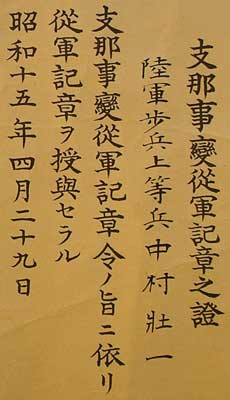
On the back upper left corner is a purple stamp
that says Series 103 and below that some lines that look like the kanji for
1-2-1-3.
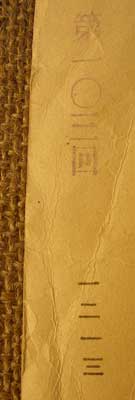
To return to the base page on
Medals, please click here: Nambu
World: Japanese Medals
To
return to “Other Japanese Militaria”, please click here: Nambu
World: Other Japanese Militaria
To
return to the home page, please click here: Nambu World: Teri’s WWII Japanese
Handgun Website
Last updated: August
15, 2006. All contents are copyright Teri
unless otherwise specified and may not be used elsewhere in any form without
prior permission.